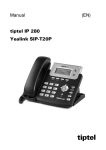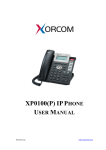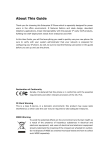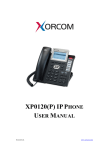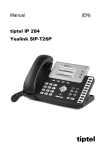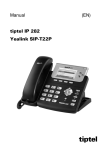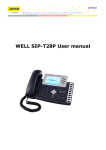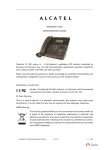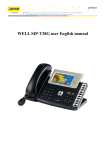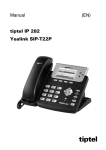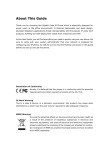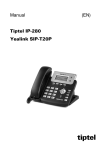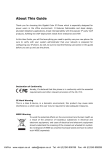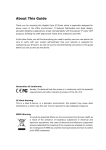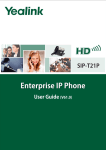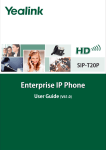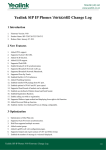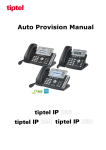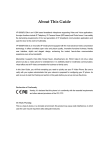Download Network Setting - JOYCE ČR, s.r.o.
Transcript
JOYCE ČR, s.r.o., Venhudova 6, 614 00 Brno, ČR, IČ: 25317571, DIČ: CZ25317571, Tel.: +420 539 088 010 Fax: +420 539 088 000, E-mail: joyce@joyce.cz, Web: www.joyce.cz, www.joyce-energie.cz WELL SIP-T20/T20P User manual Released for firmware versions V61 About This Guide Thank you for choosing this Enterprise IP Phone which is especially designed for power users in the office environment. It features fashion and sleek design, abundant telephony applications, broad interoperability with the popular 3rd party VoIP products, fulfilling the VoIP deployment needs from enterprise and ITSP. In this User Guide, you will find everything you need to quickly use your new phone. Be sure to verify with your system administrator that your network is prepared for configuring your IP phone. As well, be sure to read the Packing List section in this guide before you configure and use the phone. Declaration of Conformity Hereby, it’s declared that this phone is in conformity with the essential requirements and other relevant provisions of the CE, FCC. CE Mark Warning This is a class B device, in a domestic environment; this product may cause radio interference, in which case the user may be required to take adequate measures. WEEE Warning To avoid the potential effects on the environment and human health as a result of the presence of hazardous substances in electrical and electronic equipment, end users of electrical and electronic equipment should understand the meaning of the crossed-out wheeled bin symbol. Do not dispose of WEEE as unsorted municipal waste and have to collect such WEEE separately. Contents Getting Started ..................................................... 1 Packing List................................................................................................ 1 Assembling the Phone ................................................................................. 3 Configuration and Registration ..................................................................... 5 Configuring via Web Page ....................................................................... 5 Configuring via keypad .......................................................................... 6 Overview .............................................................. 7 Keypad Instruction...................................................................................... 7 LED Instruction .......................................................................................... 9 Icon Instruction .......................................................................................... 9 User Interface .......................................................................................... 10 Customizing Your Phone ..................................... 12 General Settings ....................................................................................... 12 Phone Status ...................................................................................... 12 Language ........................................................................................... 12 Time and Date .................................................................................... 13 Keypad Lock ....................................................................................... 14 Audio Settings .......................................................................................... 16 Volume .............................................................................................. 16 Ring Tones ......................................................................................... 16 Codec Selection .................................................................................. 18 Contact Management ................................................................................ 19 Configure/Add/Delete Contact .............................................................. 19 Import/Export Contact list .................................................................... 22 Blacklist ............................................................................................. 23 Other Settings .......................................................................................... 23 Key as Send ....................................................................................... 23 Hot Line ............................................................................................. 24 Headset Prior ...................................................................................... 25 Dual Headset ...................................................................................... 26 Anonymous call .................................................................................. 26 Auto Redial ......................................................................................... 27 Auto Answer ....................................................................................... 28 Missed call log .................................................................................... 29 Logo Customization ............................................................................. 31 Programmable Key .............................................................................. 31 Live Dialpad ....................................................................................... 32 Replace Rule....................................................................................... 33 Dial Now ............................................................................................ 34 Area Code .......................................................................................... 35 Block Out ........................................................................................... 36 Feature Synchronisation ....................................................................... 37 WatchDog .......................................................................................... 38 Basic Call Functions ............................................ 39 Making a call ............................................................................................ 39 Call Devices........................................................................................ 39 Call Methods ....................................................................................... 39 Password dial ..................................................................................... 41 Call Completion................................................................................... 41 Answering a call ....................................................................................... 42 Answering an incoming call .................................................................. 42 Denying an incoming call ..................................................................... 42 DND .................................................................................................. 42 Call Forward ....................................................................................... 42 Intercom ............................................................................................ 44 During an Active Call ................................................................................. 44 Mute.................................................................................................. 44 Call Hold ............................................................................................ 45 Call Waiting ........................................................................................ 45 Call Transfer ....................................................................................... 46 3-way Conference ............................................................................... 47 Network Conference ............................................................................ 47 Voicemail ........................................................................................... 48 Advanced Phone Functions ................................. 50 Account Setting ........................................................................................ 50 TLS ................................................................................................... 50 DNS-SRV ........................................................................................... 51 Network Setting ....................................................................................... 52 PC Port Setting ................................................................................... 52 VLAN Setting ...................................................................................... 53 LLDP.................................................................................................. 54 HTTPS ............................................................................................... 55 Maintenance Tasks .................................................................................... 56 Administrator Mode ............................................................................. 56 Administrator/User Password ................................................................ 57 Reboot ............................................................................................... 57 Reset to Factory .................................................................................. 57 Firmware Update................................................................................. 58 Zero-sp-touch ..................................................................................... 60 System Log Export .............................................................................. 61 PCAP Trace Export ............................................................................... 61 802.1X .............................................................................................. 61 DSS keys Configuration ............................................................................. 61 Line ................................................................................................... 63 Speed Dial ......................................................................................... 63 BLF ................................................................................................... 63 BLF List.............................................................................................. 63 Voice Mail ........................................................................................... 64 Pick Up .............................................................................................. 64 Group Pick up ..................................................................................... 64 Call Park ............................................................................................ 65 Intercom ............................................................................................ 65 DTMF ................................................................................................. 66 Prefix................................................................................................. 66 Local Group ........................................................................................ 66 Conference ......................................................................................... 66 Forward ............................................................................................. 67 Transfer ............................................................................................. 67 Hold .................................................................................................. 67 DND .................................................................................................. 67 Redial ................................................................................................ 68 Call Return ......................................................................................... 68 Record ............................................................................................... 68 URL Record ........................................................................................ 68 Multicast Paging .................................................................................. 69 Group Listening .................................................................................. 70 Public Hold ......................................................................................... 70 Private Hold........................................................................................ 71 Shared Line ........................................................................................ 71 Automatic Call Distribution (ACD) .......................................................... 71 Zero-sp-touch ..................................................................................... 72 URL ................................................................................................... 72 SNMP ...................................................................................................... 73 Action URL ............................................................................................... 74 Action URI ............................................................................................... 75 Music on Hold........................................................................................... 76 SIP Diversion Display ................................................................................ 77 Suppress DTMF Display ............................................................................. 78 Tone Settings ........................................................................................... 79 Voice ....................................................................................................... 79 Ring ........................................................................................................ 81 Trouble Shooting .................................................. 2 Enterprise IP Phone Getting Started Getting Started Packing List The following components are included in your package: Enterprise IP Phone Phone Stand Power Adapter 1 Enterprise IP Phone Handset & Handset Cord Ethernet Cable Quick Installation Guide & Quick Reference CD Content Getting Started Check this list before installation to ensure that you have received each item. If you are missing any items, contact your IP phone reseller. 2 Enterprise IP Phone Getting Started Assembling the Phone This section introduce how to assemble the phone with the components in the packing list: Attach the stand; Connect Handset and Headset; Connect Network and Power. 1) Attach the Stand, as shown below: Stand attached 2) Connect Handset and Headset, as shown below: Note: Headset is not provided in the packing list. Please contact your distributor for more information. 3 Enterprise IP Phone Getting Started 3) Connect Network and Power There are two ways for network and power source connections. Users can either connect the phone to the AC Power directly using the power adapter or to a PoE compliant switch or hub. Your system administrator will advise you on which one to use. Note: 1. If inline power is provided, do not install AC adapter. Make sure the Ethernet cable and switch/hub are PoE compliant. 2. The Internet Port can be also connected to Hub/Switch/IP PBX or other internet devices. The phone can also share the network connection with other network devices such as PC. Connect the phone’s PC port and computer’s Network Port together using an Ethernet cable, shown as below: 4 Enterprise IP Phone Getting Started Configuration and Registration If you are administrator, you need to do some simple configuration to make the phone work. If not, please contact with your system administrator or system administrator for more details. Configuring via Web Page Press OK button on the keypad of the phone to enter the status page and find out the IP address of IP phone. Enter it (for example http://192.168.3.28) into the address bar of web browser. The default administrator’s login name and password are admin/admin. The default user’s login name and password are user/user. Note: Please locate your PC in the same network segment of IP phone (192.168.3.X) to access the web configuration page. Please consult your system administrator for help. Network Settings Click on Network->Internet Portn (WAN). DHCP: Under the default situation the phone attempts to contact a DHCP Server in order to obtain its valid network settings, e.g. IP address, subnet mask, gateway, DNS server, etc. Static IP Address: If your phone cannot connect a DHCP Server for any reason, you need to enter the network settings manually via Static IP Address. Please contact your system administrator for more details. PPPoE: If you are using the xDSL Modem, users can connect your phone to the internet via PPPoE mode. Please contact your ITSP for the User Name and Password for internet access. Note: Using the wrong network parameters may result in inaccessibility of your phone and may also have an impact on your network performance. Please contact your network administrator. Account Settings The phone attempts to register to the SIP server using the account data provided by the automatic or manual initialization. Click on Account, you will find the following parameters: Field Register Status Account Active Label Display Name Field Register Name User Name 5 Description It shows the register status of the phone. Users can select on/off to enable/disable the account respectively. The name showing on the LCD of current device. The local phone name showing on the other phone when calling. Description Register name provided by ITSP. User account information, provided by ITSP. Enterprise IP Phone Password SIP Server Getting Started Account password provided by ITSP. SIP server address provided by ITSP. When all accounts register fail, phone will display "No Service" by default. When the phone reboot, it will register automatically. If many phones register at the same time, this will affect the server, the users can configure the register power up time so that the phone will random register automatically within the configured time. To configure the power up time via web interface: Select Network->Advanced-> Registration random, enter the time in the field. Note: Should the IP PBX (SIP registrar) require an authentication, you will be prompted to enter the correct password. Make sure you are using the appropriate input method or enter the password via the web user interface. Configuring via keypad Network Settings: Press MENU->Settings->Advanced, enter the password, and select Network->WAN Port/PC Port /VLAN/Web Type/802.1x Settings to enter the internet relating configuration page. Account Settings: Press MENU->Settings->Advanced, enter the password, and select Accounts->OK to configure the account settings. Users can refer to “Configuring via Web Page” for the parameter details. 6 Enterprise IP Phone Overview Overview Keypad Instruction Users can check the following list which introduces the IP phone’s keypad in details: Power Indication LED It will show the power status, it will be on if the phone is powered, off if the phone is not powered,and blink when someone calls in or there is a call on mute. Hot Keys In different interfaces, different functions of the hot keys. Line Keys This buttons are used to active up to the two user accounts. DTMF Keypad Use the DTMF hard keys to enter numbers, letters and special characters. Depending on the selected input mode, users can enter digits, lower / upper case or special characters. 7 Enterprise IP Phone Overview Navigation Keys Use the navigation keys to navigate in the display Menus and Confirm/cancel actions. Audio Device Control Keys Use the audio device control keys to perform the following actions depending on your phone type: : Adjust the volume of the handset, headset, speaker and ring tone; : Allows for hands-free communication during calls; Press to switch to the Group Listening mode. : Place and receive calls through an optionally connected headset; : Mute audio transmission locally during calls; Hard Feature Keys : Allow users to access the voicemail directly; : Forward the current call to the third party; When the phone is idle, press to enter the forward configuration page. : Press to enter the Dialed Calls interface and select a record to dial out. 8 Enterprise IP Phone Overview LED Instruction Table 1 Line Keys LED Status Steady green Blinking green Description The account is active There is an incoming call to the account, or there is a call on hold The phone is in idle status whatever registered /unregistered Off Table 2 Line Keys configured as BLF LED Status Steady green Fast blinking green Slow blinking green Off Description The monitored account is in idle status There is an incoming call to the monitored account The monitored account is on a conversation It is not active as BLF Table 3 Power Indication LED LED Status Steady green Blinking green Off Description Power on There is incoming call to the device, or there is a call on mute Power off Icon Instruction The IP Phone displays different kinds of icons on its LCD, users can refer to the following table for their meanings: Icon Description Flashes when the internet is disconnected Missed calls Call in Call out Input Method: all letters and numbers Input Method: numbers Input Method: multi-lingual letters in lower case Input Method: multi-lingual letters in upper case Call mute Call hold Voicemail Icon 9 Description Enterprise IP Phone Overview Call forward Auto answer DND Keypad Lock In handset mode In headset mode In speaker mode User Interface There are two ways to customize specific options on your phones: 1. Using keypad and display on the phone. 2. Using Web user interface in an Internet browser from your PC; please refer to “Configuration and Registration” to get into the Web interface. In many instances, it is possible to use both the user interfaces to operate the phone and change settings; some, however, are only possible via a phone or web user interface. Please refer to the following table for differences: Phone Options Status --IP --MAC --Firmware --Network --Phone --Accounts Call Features --Forward --Call Waiting --DSS Keys --Key as Send --Hot Line --Anonym Call --Auto Redial --DND --ReDialTone --Emergency --BusyToneDelay --Return code when refuse --Return code when DND --Dial Plan --Tones --Intercom --Call Completion 10 Phone UI √ √ √ √ √ √ √ √ √ √ √ Web UI √ √ √ √ √ Enterprise IP Phone Basic Phone Functions --Language --Time & Date --Ring Tone --Phone Volume Advanced Phone Functions --Accounts --Network --Keypad Lock --Reset to Factory --Set AES Key --Set admin PWD --Voice --Upgrade Other Features --Messages --History --Directory Overview √ √ √ √ √ √ √ √ √ √ √ √ √ √ √ √ Note: 1. The above table only indicates most of phone functions rather than all of them. Please refer to the relating parts for more details. The default administrator password is admin. 11 Enterprise IP Phone Customizing Your Phone Customizing Your Phone General Settings Phone Status Users can view the status of your phone using the Phone interface or the Web interface. This option allows you to review: IP; MAC; Firmware; Network: MAC, WAN, LAN, Gateway, DNS, etc; Phone: Model, Hardware, Firmware, Product ID and MAC; Accounts: The 2 SIP accounts status; To check the Phone Status via Phone interface: 1) Press OK button directly to check the IP. 2) Use the navigation keys to check the other information. To view the Phone Status via Web interface: Open the web browsers and input the IP Address http://WAN-ip-address; Enter the account and password (default account and password are admin/admin), select Status directly to check the status. Language The default Phone interface language is English. The Web interface language depends on your computer Operation System. It will automatically match the language with your computer and browser. It also supports French, German, Italian, Polish, Turkish, Portuguese, Spanish, etc. Users can change the language for the phone user interface and the web user interface independently from each other. Note: All languages may not be available for selection. The available languages depend on the language packs currently loaded to the IP phone. Please contact with your system administrator for more information about loading language packs. To change the language via Phone interface: 1) Press MENU->Settings->Basic->Language. 12 Enterprise IP Phone Customizing Your Phone 2) Scroll through the list of available languages. 3) Press OK button when the desired language is highlighted. The language appears on the graphic display will be changed to the one you select. 4) Press MENU key to return to the previous screen. Time and Date The time and date appears on the idle screen of the IP phone. If the phone cannot obtain a time and date from the call server, please contact your system administrator if the time or date is incorrect. Users can configure the time manually or via the SNTP server which is used to synchronize the time. To change the Time and Date via the Phone interface: 1) Press Menu->Settings->Basic->Time & Date. 2) If SNTP is selectn, the phone will automatically get the time from the specific NTP Server. Use the navigation keys to highlight the specific options and do the relating changes. Users can configure the Time Zone, NTP Server1/Server2, and DST respectively. 3) If Manual is selectn, the time can be configured manually. Use the navigation keys to highlight the option and enter the specific date and time. 4) Press OK button, the time appears on the idle screen will be changed. Or press Menu key to return to the previous screen. To configure the time format via the Phone interface: 1) Press Menu->Settings->Basic->Time & Date->Time & Date. 2) Use the Left/Right navigation keys to select a preferred time format: 12 hour or 24 hour. 3) Press OK button to save the changes and return to the previous screen. To change the Daylight Saving Time Settings via the Web interface: 1) Click on Phone->Preference->Daylight Saving Time to do the relating changes. 2) Select Enable option, then users can configure the Daylight Saving Time. 3) Select Automatic. There is a table named as AutoDST.xml has been saved in the configuration file, If the table includes daylight saving time of your time zone, it will show the Fixed Type: By Date or By Week. And the daylight saving time is 13 Enterprise IP Phone Customizing Your Phone unchangeable, unless to update the AutoDST.xml via auto provision. Note: By default the time zone is +8 China(Beijing), Daylight Saving Time is Automatic. Keypad Lock Users can lock the keypad of your phone when you are temporarily not using it. This function helps you to protect your phone from unauthorized use. Users can lock the following specific keys: Menu Key: The Menu keys can not be used until unlocked. Users can not access the Menu of the phone. Function Keys: The hard function keys can not be used until unlocked. Users can not access the MESSAGE, HEADSET, TRAN, RD, Speaker, CONF, HOLD, Navigation Keys, OK button, Mute button, Volume Adjustment button, etc. All Keys: All of the keys can not be used until unlocked. Users can only use the phone to answer the incoming calls. Lock&Answer: Users can only use the phone to answer the incoming calls(But can not hung up the call by your party). Or enter the Menu pages to do some configurations. To enable keypad lock via Phone interface: 1) Press MENU->Settings->Advanced, enter the password, and then press OK button. 14 Enterprise IP Phone Customizing Your Phone 2) Select Keypad Lock. 3) Use the navigation keys to highlight the one you want to lock. 4) Press OK button to active the change, or Menu to return to the previous screen. 5) The icon will be displayed on the top right corner of the idle screen. 6) If you select Lock&Answer, it will show the icon interface. and AA on the user To unlock the phone via Phone interface: 1) Press Menu key, you are prompted for the password. 2) Enter the password, and then press OK button, the phone is unlocked. 3) If you select Lock&Answer, you have to enter MENU->Settings->Advanced- > Keypad Lock interface to disable this option. To enable keypad lock via Web interface: Click on Phone->Preference-> Keyboard Lock to do the relating changes. Please refer to the instructions above for the parameters’ detail. Note: 1. The default password for unlock is admin. 2. Users can make emergency calls when the phone is locked. 15 Enterprise IP Phone Customizing Your Phone Audio Settings Volume Users can adjust the volume of handset/speaker/headset. To adjust the volume when you are not in an active call: 1) Press Menu->Settings->Basic. 2) Scroll to Phone Volume, and press OK button, highlight the one you want to adjust the volume, use the Volume Adjustment Bar or navigation keys to adjust the volume. 3) Press OK button to save the contrast change or Menu key to cancel. 4) And users can also press the Volume Adjustment Bar to adjust the ring volume when the phone is in idle status. To adjust the volume when you are in an active call: When Handset/Headset/Hands-free mode is activated, press the Volume Adjustment Bar to a comfortable level. Note: The volume can only be adjusted via Phone interface. Ring Tones Users can adjust the type and volume of the ring tone. To adjust the Ring Tone Type via Phone interface: 1) Press Menu->Settings->Basic. 2) Scroll to Ring Tone, and press OK button. 3) Use the navigation keys to highlight the specific one. 4) Press OK button to save the contrast change or Menu to cancel. To adjust the volume via Phone interface: 1) Press Menu ->Settings->Basic. 2) Press Phone Volume->Ring Volume, use the Volume Adjustment Bar or navigation keys to adjust the volume. 3) Press OK button to save the contrast change or Menu key to cancel. To change the Ring Tone Type via Web interface: Click on Phone->Preference->Ring Type, highlight the specific one in the scrolldown Menu, click Confirm button to save the change. Users can also delete the specific one by clicking the Delete button. 16 Enterprise IP Phone Customizing Your Phone Note: The ring tone file of system cannot be deleted. To upload the new Ring Tone via Web interface: 1) Click on Phone->Preference->Upload Ringtone. 2) Click Browse button to select the specific ring tone file. 3) Click Upload button to upload the file. Note: The ring tone file format must be in 16bits WAV format (via Ulaw Compression), 8K sample rate (monophony). Blank or other special characters can not be included in the file name. 17 Enterprise IP Phone Customizing Your Phone To specify ring tones for a specific account via Web interface: Click on Account->Basic->Ring Type option, and highlight the preferred one for the selectn account in the scroll-down menu, then click Confirm button to update the change. Codec Selection The IP phone supports the following voice codecs: G722, G723_53, G723_63, G726-16, G726-24, G726-32, G726-40, G729, PCMU and PCMA Users can enable/disable the desired codecs via Web interface. Please contact your System Administrator for more details about the codecs. 18 Enterprise IP Phone Customizing Your Phone To enable/disable the codecs: 1) Click on Account->Codecs. 2) Use the navigation keys to highlight the desired one in the Enable/Disable Codecs list, and press the 3) / to move to the other list. Click Confirm button to save the change. Note: 1. Codec Selection can be only configured via Web interface. 2. If codec G722 is negotiated, the LCD screen prompts call in process with HD voice. Contact Management Configure/Add/Delete Contact Users can store a large number of contacts in your phone's directory. Users can add, configure, delete, dial, or search for a contact in this directory. The directory includes Local Directory and Blacklist. To add a Group via Phone interface: 1) Press Menu->Directory->Local Directory 2) Use left/right navigation keys to select AddGroup, press OK button to enter to the Add Group page. 3) Enter the group name and select the ring. 19 Enterprise IP Phone 4) Customizing Your Phone Press OK button to save. To add a contact via Phone interface: 1) Press Menu->Directory->Local Directory. 2) Select a group, and press OK button. 3) Press Up/Down navigation key to ADD page. Press OK button to start adding a new contact, enter Name, phone number of the contact by the keypad. Use the 2aB to select between numeric and upper/lower case alphanumeric modes. 4) Select and configure a special ring tone for the contact. 5) Use the navigation keys to select the group which you want to configure. 6) Press OK button to add the contact, or Menu key to cancel the change. To configure/delete a contact via Phone interface: 1) Press Menu->Directory->Local Directory. 2) Select a group, and press OK button. 3) Use the Up/Down navigation key to highlight the contact you want to configure/delete, then press left/right navigation keys to Configure/Del page. 4) Make the desired changes, press OK button, or press Menu return to previous menu. To move a contact to the Blacklist via Phone interface: 1) Press Menu->Directory->Local Directory. 2) Select a group, and press OK button. 3) Use the Up/Down navigation keys to highlight the contact you want to move, then press left/right navigation keys to M2B page. 4) Make the desired changes, press OK button, or press Menu return to previous menu. 5) It will pop up a warning frame asking whether Confirm to move the contact. 6) Press OK button to confirm the operation, or press the Menu button to return to the directory. To move a contact in History to Contacts via Phone interface: 1) Press MENU->History. 2) Use the navigation keys to highlight a record, then press the CONTACT hot key to enter the configure page. 20 Enterprise IP Phone Customizing Your Phone To add/delete/configure the contact list via the Web interfaces: Click on Contacts and then do the relating changes. Please refer to the instruction above for the parameters’ detail. To search a contact via Phone interface: 1) Press the CONTACT hot key to enter the contact list. 2) Press the digital number on the keypad, it will turn to the search interface automatically, and search the record in Contact. 21 Enterprise IP Phone Customizing Your Phone Import/Export Contact list Import/Export Contact List via Web interface: 1) Click on Contacts->Local Phone Book. 2) Browse the specific contact list file in .XML format or .csv format, and then click Import button. The imported contact lists will be shown in the directory. 3) Move the mouse to the icon ; you will see the notes for parameters. The meanings of this icon on other pages is the same, we will not elaborate it one by one. 4) Click the Export button to export the contact list. Note: Import/Export Contact List can be only configured via Web interface. 22 Enterprise IP Phone Customizing Your Phone Blacklist If you add a contact to blacklist, then the call from this contact cannot get through. The operation of blacklist is the same as contact. Other Settings Key as Send Users can configure a specific button (“#” or “*”) to active as the send button. To configure the send key via the IP phone interface: 1) Press Menu->Features->Key as Send to enter the configuration page. 2) Press the Left/Right navigation keys to select a button that you want to use as the send key: “#”, “*”, or disable this option. 3) Press OK button to save the changes. To configure the send key via the Web interface: 1) Click on Phone->Features->Key As Send. 23 Enterprise IP Phone 2) Customizing Your Phone Highlight the specific one in the pull-down menu, then click Confirm button to save the change. Hot Line To configure the hot line number via the IP phone interface: 1) Press Menu->Features->Hot Line to enter the configuration page. 2) Enter the hot line number and configure the HotLine Delay (for example, 20 seconds), then press OK button to save the changes. 3) When you pick up the handset or press the speaker button, and it will dial out the number automatically if you do not press any keys for 20 seconds. To configure the Hot Line via the Web interface: 1) Click on Phone->Features. 24 Enterprise IP Phone 2) Customizing Your Phone Input the Hotline Number and Hotline Delay, and then click Confirm button to save the change. Headset Prior Headset prior allows the phone to use headset in priority. To place a call using Headset Prior, enable the Headset Prior feature, physically connect your headset and press the HEADSET button to activate it for use. Press the desired numeric keys to place a call will now connect to the headset automatically. To receive a call using Headset Prior, enable Headset Prior feature, physically connect your headset and press the HEADSET button to activate it for use, press the Line key or the Answer soft key to receive a call will now connect to the headset automatically. To enable Headset Prior via Web interface: 1) Click on Phone -> Features; 2) Select Enabled in the pull-down menu of Headset Prior; 3) Click Confirm to save the configuration. Note: The headset icon on the LCD screen or a headset button in steady green indicates that the headset mode is activated. 25 Enterprise IP Phone Customizing Your Phone Dual Headset Dual headset allows users to use two headsets. To use this feature, you must connect your headsets to headset jack and handset jack respectively. Once the phone joins in a call, people with the Headset connected to the headset jack has a full-duplex conversation, another people with the headset connected to the handset jack is only allowed listening. To enable Dual Headset via Web interface: 1) Click on Phone -> Features; 2) Select Enabled in the pull-down menu of Headset Training; 3) Click Confirm to save the configuration. Anonymous call To configure the anonymous call via the IP phone interface: 1) Press Menu->Features->Anonym Call to enter the configuration page. 2) By the navigation keys, users can select the Line ID. 3) Press the navigation keys to select whether to enable the anonymous call function. This feature allows the subscriber to make a call with the display of their calling identification information blocked. 4) If you want to realize this function by server, please select and enter the Anonym On Code and Anonym Off Code. When you select to enable the anonymous call function on your IP phone, it will send information to the server, and the server will enable/ disable the anonymous call function for your IP phone automatically. 5) Press the navigation keys to enter and select whether to enable the Anonymous Rejection function. The feature allows the subscriber to reject all calls from callers who have blocked the display of their calling identification information (calling number and calling name). 6) If you want to realize this function by server, please select and enter the Reject On Code and Reject Off Code. When you select to enable the Rejection option on your IP phone, it will send information to the server, and the server will enable/ disable the rejection anonymous call function for your IP phone automatically. Note: This configuration is only available for the current default account. 7) Press OK button to save the changes. 26 Enterprise IP Phone Customizing Your Phone To configure the anonymous call via the Web interface: 1) Click on Account-> Basic-> Anonymous Call to do the relating changes. Please refer to the instruction above for the parameters’ detail. 2) Click Confirm button to save the changes. Auto Redial Auto redial is a telephone feature that redials a busy number in a fixed number of times before giving up. To configure auto redial via the IP phone interface: 1) Press Menu->Features->Auto Redial to enter the configuration page. 2) By the navigation keys, users can select whether to enable the Auto Redial function. 3) Press the navigation keys to select and configure the Redial Interval. It is measured by seconds. 4) Press the navigation keys to select and configure the redial times. 5) Press OK button to save the changes. Note: If you enable the auto redial function, then without operations for 5 seconds in the auto redial interface, it will turn to the idle interface automatically. To configure auto redial via the Web interface: 27 Enterprise IP Phone Customizing Your Phone 1) Click on Phone->Features->Auto Redial. 2) Select Enabled or Disabled in the pull-down Menu, then click Confirm button to save the change. Auto Answer Auto-answer allows an incoming call to be answered without requiring any action by the user. This is a useful feature for people who have difficulty in using their hands or fingers, who have a visual impairment, or who have a cognitive impairment. Users can configure this function to a special account. To configure Auto Answer via the IP phone interface: 1) Press Menu->Settings->Advanced, enter the password and press OK button 2) Then press Accounts->Line X to enter the configuration page, use the navigation keys to select Auto Answer option. 3) Use the navigation keys to enable or disable the auto answer function. The default is Disable. 4) Press OK button to save the changes. To configure Auto Answer via Web interface: 1) Click on Account->Basic->Auto Answer. 2) Select Enabled or Disabled in the pull-down menu. 3) Click Confirm button to save the change. 28 Enterprise IP Phone Customizing Your Phone Missed call log Defines whether to save the missed calls to the call history record. This function can only be configured via the Web interface: 1) Click on Account->Basic->Missed call log. 2) Select Enabled or Disabled in the pull-down menu. 29 Enterprise IP Phone 3) Click Confirm button to save the change. 30 Customizing Your Phone Enterprise IP Phone Customizing Your Phone Logo Customization Users can configure text logo which shown in the idle screen 1) Click on Phone-> Features-> Use Logo via the Web interface, select Enable or Disable in the pull-down menu. 2) If you select Enable, and then enter the text logo in the Text Logo field. 3) Click Confirm button to save the change. Programmable Key The hot-key, navigation keys and function keys on the keypad are configureable. Users can customize specific features for these keys according to their actual needs. (The programmable keys can only be available when the phone is idle.) 31 Enterprise IP Phone Customizing Your Phone This function can only be configured via the Web interface: 1) Click on Phone->DSS Key->Programmable Key. 2) Select and customize specific features for these keys. 3) Click Confirm button to save the changes. Live Dialpad Defines whether to dial out the dialed number automatically. This function can only be configured via the Web interface: 1) Click on Phone->Preference->Live Dialpad. 2) Enable or disable it in the pull-down menu. 32 Enterprise IP Phone 3) Customizing Your Phone Click Confirm button to save the change. Replace Rule A dial plan establishes the expected number. This includes country codes, access codes, area codes and all combinations of digits dialed. For example if you configure the Prefix as 0 and Replace as 0086 (Chinese country code), when you dial 0 out, the number will be replaced by 0086 automatically. 33 Enterprise IP Phone Customizing Your Phone To configure a Dial Plan via the Web interface: 1) Click on Phone->Dial Plan->Replace Rule. 2) Enter the desired Prefix, Replace and Account. 3) Click Add button to save the changes. 4) Users can also delete a specific one from the dial plan list byclicking Del button. 5) Users can select a record to modify, then click Configure button to submit. Dial Now Dial-now enables you to define the specific length of any number/letter in advance(for example xxx), next time when users dial out the 123 whose length matches the Dial-now rule, the phone will dial out 123 immediately without pressing Send button. 34 Enterprise IP Phone Customizing Your Phone To configure a Dial Plan via the Web interface: 1) Click on Phone->Dial Plan->Dial Now. 2) Enter the number in Dial-now Rule and Account. 3) Click Add button to save the changes. 4) Users can select a record to modify, then click Configure button to submit. 5) Users can also delete a specific one from the dial plan list by clicking Del button. 6) Users can also configure the Time Out for Dial-now Rule via web interface. Click on Phone->Features->Time Out for Dial-now Rule, enter the time. Note: 1. If need to replace the unknown contents, then users can use (.) or (x), “.” stand for a string of char, “x” stand for any one char. The content in () stand for a variable, the first variable is expressed by $ 1, the second variable is expressed by $ 2, the rest can be done in the same manner. For example: if you want to replace the any input content with the content beginning with 8. Input (.) in Prefix box, and input 8$1 in Replace box. Area Code Area codes are also known as Numbering Plan Areas (NPAs). These are necessary (for the most part) only when dialed from outside the code area and from mobile phones. Area codes usually indicate geographical areas within one country, although the correlation to geographical area is becoming obsolete. For non-geographical numbers, as well as mobile telephones outside of the United States and Canada, the "area code" does not correlate to a particular geographic area. 35 Enterprise IP Phone Customizing Your Phone To add the area code via the Web interface: 1) Click on Phone->Dial Plan->Area Code. 2) Enter the Code and Account, configure the Min Length and the Max Length, and then click Confirm button to save. Block Out The specific phone numbers can be forbidden to be call out from your IP phone. 1) Click on Phone->Dial Plan->Block Out. 2) Enter the phone number and Account and click Add button to save the changes, or select the specific one in the list, click Del button to delete the record. 3) Users can select a record to modify, then click Configure button to submit. 36 Enterprise IP Phone 4) Customizing Your Phone Users cannot dial out the number from your IP phone unless it is removed from the forbidden List. Note: 1. In the Account field, users can enter 1,2,3…, “1” represents Account 1, “2” represents Account 2 ……, if the account box is empty, it mean this rule works for all accounts . Feature Synchronisation When enabled the synchronize function, configure the DND/FWD function on device or server, DND/FWD status on device and server will be in correspondence. To configure Feature Key Synchronisation via the Web interface: 1) Click on Phone->Features-> Feature Key Synchronisation 2) There is a pull-down menu in the Type field, select Intercom from the list. 3) Select whether to enable this function from the pull-down menu. 37 Enterprise IP Phone 4) Customizing Your Phone Click Confirm button to save the change. WatchDog When 'WatchDog' function is 'Enabled', phone will auto reboot after 10 seconds if some important process of phone crash. When 'Disable' the function , the phone will not reboot. Configure watchdog via web interface: Click on Phone-> Preference->WatchDog, in the pull-down menu, select enable or disable this function. 38 Enterprise IP Phone Basic Call Functions Basic Call Functions Making a call Call Devices Users can make a phone call via the following devices: 1) Pick up the handset, icon will be shown in the idle screen. 2) 3) Press the Speaker button, icon will be showed in the idle screen. Press the Headset button if the headset is connected to the Headset Port in advance. In the dial-up interface, the icon will be showed in the idle screen. Users can also dial the number first, and then select the method you will use to speak to the other party. Call Methods Users can dial the number directly if you didn’t register a account but fill the SIP Server in the registered interface. But the number which you dial must be in the same SIP server. Users can press an available line button if there is more than one account, then 1) Dial the number you want to call, or 2) Go to Directory, use the navigation keys to highlight your choice, or 3) Press the Up navigation key to enter the call history interface, then use the navigation keys to highlight your choice (press Left/Right navigation keys to select All Calls, Missed Calls, Dialed Calls, Received Calls and Forwarded Calls) or 4) Press the RD button to enter the Dialed Calls interface, and then select a record to dial out. 5) Then press the SEND button to dial out if necessary. 39 Enterprise IP Phone Basic Call Functions And users can also dial-up via web interface: 1) Click on Contact->Local Phone Book/BlackList, click the number which you want to dial out, and then the phone will dial out by default account. 2) Or click on Contact->Phone Call Info, enter the number in the Dial a Number, select the line from the Outgoing Identity list. Then click the Dial button to call out. 3) Or click on Contact->Phone Call Info, click the number which you want to dial out from the call list, the phone will dial out by corresponding account. 40 Enterprise IP Phone 4) Basic Call Functions Users can click the Hangup button to end the call in the web page. Password dial When number entered is beginning with the password prefix, the following N numbers after the password prefix will be hidden as *, N stand for the value which you enter in the PswLength field. For example: you configure the password prefix as 3, enter the PswLength as 2, then you enter the number 34567, it will display 3**67 on the phone. To configure password dial via web interface: 1) Click on Phone->Features->PswDial, in the pull-down menu, select Enable. 2) Enter the password prefix in the PswPrefix field 3) Enter the Length in the PswLength field. 4) Click Confirm button to save the changes. Call Completion Have encountered such a situation? When you call a contact, but the other side is busy on a call. Do you want the server to inform you immediately when the contact end the call, in order to establish a conversation with each other in time? Call Completion can help you to solve this problem. To configure Call Completion via phone interface: 1) Press MENU->Features->Call Completion to enter the configuration page. 41 Enterprise IP Phone Basic Call Functions 2) By the Left/Right navigation keys, select whether to enable this option. 3) Press OK button to save your changes. Answering a call Answering an incoming call 1) If you are not on an active call, lift the handset using, or press the Speaker button to answer it using the speakerphone, or press the HEADSET button to answer it using the headset. 2) If you are on an active call, press the corresponding line key or OK button to answer it. During the conversation, users can alternate between Headset, Handset and Speaker mode by pressing the corresponding buttons or picking up the handset. Denying an incoming call Press the X key to deny the incoming call directly. DND If users enable the DND function, all the incoming calls will be rejected and the display shows: icon; Users can find the incoming call record in the Call History. To configure the DND function via Phone interface: 1) Press Menu->Features->DND to enter the configuration interface. 2) Use the navigation keys to select Enable/Disable. 3) Press OK button to save the changes. 4) Select DND option again to deactivate DND mode. Users can also configure DND function by the DND Code: 1) Press Menu->Features->DND to enter the configuration interface. 2) Configure the DND On Code and the DND Off Code, then press OK button to save the changes. 3) When you enable the DND function, the phone will send a message to the server, and the server will turn on the DND function. Then any calls to the extension will be rejected by the server automatically. And the incoming call record will not be displayed in the Call History. Call Forward This feature allows you to forward an incoming call to another phone number e.g. a cell phone or voice mailbox. The following call forwarding events can be configured: Always: Busy: 42 Incoming calls are immediately forwarded. Incoming calls are immediately forwarded when the phone is busy. Enterprise IP Phone Basic Call Functions No Answer: Incoming calls are forwarded when the phone is not answered after a specific ring times. To configure Call Forward via Phone interface: 1) Press Menu->Features->Forward. Users can also press the Tran button or the corresponding DSS key to enter the forward setting page directly when the phone is idle. 2) There are 3 options: Always, Busy and No Answer. 3) If you select one of them, enter the phone number you want to forward. 4) If you want to realize this function by server, please enter the On Code and Off Code, then when you select to enable the call forward function via your IP phone, it will send message to the server, and the server will turn on the function immediately. When there is call to the extension, the server will forward it to the configured number automatically based on the forward type. And the IP phone will not show the record in the call history anymore. 5) Press OK button to save the changes. To configure Call Forward via Web interface: Click on Phone->Features->Forward to do the relating changes. Please refer the above configuration information. 43 Enterprise IP Phone Basic Call Functions In addition, you can enable or disable the phone to forward an incoming call to international number which begins with the international call prefixes of 00. If you need specify the international call prefix, contact your system administrator for more information. Forward international is enabled by default. To configure Forward International via phone interface: 1) Press Menu -> Settings -> Advanced Settings -> Fwd International. 2) Select Disable or Enable in the pull-down menu of Fwd International. 3) Press Save to save your changes. Intercom Intercom mode is useful in an office environment as a quick access to connect to the operator or the secretary. To configure Intercom option via phone interface: 1) Press Menu->Features->Intercom to enter the configuration page. 2) Intercom Allow: To configure whether to answer the incoming intercom calls. 3) Intercom Mute: To configure whether to mute the incoming intercom calls automatically. 4) Intercom Tone: To configure whether to play ring tones when there is incoming intercom calls to your extension. 5) Intercom Barge: To configure whether to answer the incoming intercom calls during a conversation. If the option is enabled, when there is incoming intercom calls to your extension, if you are on an intercom conversation, it will refuse the call automatically; or it will put the current call on hold and put the incoming intercom call through. 6) Select and configure the different options by navigation keys. 7) Press OK button to save your changes. During an Active Call Mute This function allows you to mute the microphone of the active audio device during a call; users can not be heard by the other party. Users can still hear all other parties while mute is enabled. To mute/resume the conversation: Press button during a conversation to mute the current call, the icon will be shown on the LCD, and the power indication LED will blink. Press again to get the microphone return to normal conversation. When you press the MUTE button all of the conversations will be muted 44 Enterprise IP Phone Basic Call Functions Call Hold This call function allows you to place an active call on hold. In this case your IP PBX might play a melody or message to the other party while waiting. Other calls can be received and made while having a call on hold. To hold/resume a call: 1) Press the HOLD button to put your active call on hold. 2) During the call, there will be a "dodo.." sound for each 30 second, suggesting that there is a current call in hold state. 3) If there is only one call on hold, press the HOLD button again to retrieve the call. 4) If there is more than one call on hold, press the Up/Down navigation keys or the corresponding Line key to highlight the call, then press the HOLD button again to retrieve the call. Note: When you are under the call hold status, putting down the handset, the conversation will go on over the speaker instead of hanging up the call. Call Waiting This call feature allows your phone to accept other incoming calls to the extension no matter under which circumstances. To enable/disable Call Waiting via Phone interface: 1) Press Menu->Features->Call Waiting. 2) Use the navigation keys to active/inactive Call Waiting. 3) Use the navigation keys to enable/disable the Play Tone option. This option used to define whether to play ring tones when there is call incoming during a call. 4) Press OK button to save the changes, or Menu to return to the previous menu. 45 Enterprise IP Phone Basic Call Functions To enable/disable Call Waiting via Web interface: Click on Phone->Features->Call Waiting to do the relating changes. Users can also configure whether to open the Call Waiting Tone option in this page. Call Transfer Users can customize your phone so that incoming calls are transferred directly to the third party such as another extension, mobile phone number, etc. There are three ways to transfer the call: Blind Transfer, Attended Transfer and Semi-Attend Transfer. To Blind Transfer via phone interface: 1) A and B is on an conversation, A press TRAN Button to put B on hold, then A can dial the third telephone number C and press the TRAN Button to call out. A will turn to hold status for a short while and then turn to the idle status. 2) After C answered it, or A press the Menu key to complete the transfer. 3) A will be disconnected from the call. B can talk to C. 4) If C refused to answer the call, it will prompt A that the transfer operation is failed. If the current mode is speaker, it will ring up; if the current mode is handset or headset, it will play ring tones for every five seconds. Pressing any function keys to exit the prompt interface. This function should be supported by server. To Attended Transfer via phone interface: 1) A and B is on an conversation, A press TRAN Button to put B on hold, then A can dial the third telephone number C and press the OK or SEND button to call 46 Enterprise IP Phone Basic Call Functions out. 2) After C answered it, A and C can have a private conversation without B hearing it, then A press the TRAN button to complete the transfer. 3) A will be disconnected from the call. B can talk to C. To Semi-Attend Transfer via phone interface: 1) A and B is on an conversation, A press the TRAN button to put B on hold, then A 2) While C is ringing, A hang up or press the TRAN button. A will turn to hold can dial a new number C and press the OK or SEND button to call out. status for a short while and then turn to the idle status. 3) You will be disconnected from the call, when C pick up, B can talk to C. Note: Make sure that the SIP server you have registered supports this function. 3-way Conference Users can establish a three-party conference, during the conversation three phone parties can communicate with each other. To establish a conference: 1) Press the CONF button during an active call. 2) The first call is placed on hold. You will hear a dial tone. Dial the number to conference in, then press the SEND key. 3) Press the Menu key to stop the conference in operation before the call is answered. 4) When the call is answered, users can have a private conversation at first. And then press the CONF button, the conference call will now include you and the other two parties. 5) Hang up to disconnect all parties. Network Conference If you want to make a conference with more than three people, users can open the function of network conference. This function needs the server’s support. If you enabled this function, users can put the meeting conference on the server. To enable network conference via web interface: 1) Click on Account->Account X->Advance->Conference Type, there is a pulldown menu, select Network from the list. 2) Enter the Conference URI. 47 Enterprise IP Phone 3) Basic Call Functions Click Confirm button to save the changes. To establish a conference: 1) Press the Conf hot key during an active call. 2) Dial the number to conference in, then press the Send hot key 3) When the call is answered, press the CONF button. 4) After starting a three way conference, press Conf button to enter conference dialing interface and invite another party to participate in teleconference. 5) After starting conference, press Hold key to hold local call without influencing others in conference. Voicemail Your voice mailbox messages, which are usually stored on a media server of your local or hosted VoIP telephony system, can be accessed from your phone. New voice messages can be indicated both acoustically and visually as described below: The idle screen will indicate the new voice messages coming: The MESSAGE button will be lighted. To configure the Voicemail code via Phone interface: 1) Press Menu->Messages->Voice Mail->Set Voice Mail. 2) Use the navigation keys to highlight the line you want to configure, enter the code which the phone uses to connect to your system. Press 123 to select the proper input method. 3) Press OK button to save the change, or press Menu to return to the previous 48 Enterprise IP Phone Basic Call Functions menu. Note: Please contact your system administrator for the connecting code. Different systems have different codes. Want to see amount of Voice mail via phone interface, must enable the Subscribe for MWI via the web interface at first. 1) Click on Account->Advanced-> Subscribe for MWI. 2) Select Enable in the pull-down menu. To view the voicemail via the Phone interface: 1) Press Menu->Messages->Voice Mail->View Voice Mail. 2) Users can view the amount of the voice mail that includes new or old voice mail. 3) Select the account and press the Connect button , then you are able to listen to your new and old messages. To retrieve the new voicemail via the Phone interface: 1) Press the MESSAGE button directly, if you already configured the Voicemail number. 2) You may be prompted to enter the password which is needed to connect to your 3) Your voice mailbox is called and you are able to listen to your new and old VoIP telephony system. It depends on your system. voicemails. Note: Before retrieving the new voicemail, please make sure that the connecting code has 49 Enterprise IP Phone Basic Call Functions been set on the phone. Advanced Phone Functions Account Setting Please refer to the previous part “Configuration and Registration” for the basic account setting information. The following table lists the instruction of the field about the advanced Account Setting. Field Name UDP Keep-alive Message UDP Description Defines whether to active the phone UDP Keep-alive mechanism. The default is Enabled. Keep-alive This parameter specifies how often the phone will send a Interval(seconds) packet to the SIP server. Default is 30 seconds. Login This parameter specifies the time frequency that phone Expire(seconds) refreshes its registration. The default interval is 3600 seconds. Local SIP Port Local SIP port. The default value is 5060. The parameter allows you configuring the proxy to send RPort responses back to a particular address and port. The default is disabled. This document defines an extension to the Session Initiation Protocol (SIP). This extension allows for a periodic refresh of SIP Session Timer SIP sessions through a re-INVITE or UPDATE request. The refresh allows both user agents and proxies to determine if the SIP session is still active. Subscribe This parameter could configure the period of the subscription. Period(seconds) The default value is 3600. DTMF Type Select the DTMF type. Users can only configure these settings via Web interface. 1) Click on Account. 2) Select the desired account. 3) Click on Advanced to do the relating settings. Users can consult your system administrator for more information. TLS TLS(Transport Layer Security), an IETF standards track protocol(RFC 5246), was based on the earlier SSL specifications developed by Netscape Corporation. 50 Enterprise IP Phone Advanced Phone Functions If you make a call based on TLS , the IP phone UI will display the icon in ring back interface. Click on Account->Basic, select Transport option, in the pull-down menu, users can select the TLS option, then click Confirm button to save the change. DNS-SRV If the SIP server cannot be used, the phone will be connected on the server which is available. To configure DNS-SRV via web interface: 51 Enterprise IP Phone Advanced Phone Functions Click on Account->Basic, select Transport option, in the pull-down menu, users can select the DNS-SRV option, and then click Confirm button to save the change. Network Setting PC Port Setting Please refer to the previous part “Configuration and Registration” for the basic Network WAN setting information. The following table lists the instructions of the field about the Network PC Port Setting. Field Name As Bridge Description If you select the Bridge mode, then the two Fast Ethernet ports will be transparent. As Router If you select the Router mode, the SIP phone will work as a router. IP address User could configure the PC port IP address. If you configure the DHCP server on, the device connected to the Enable DHCP Server PC port will get the IP address automatically between the start IP address and the end IP address. But if you select the bridge mode, the DHCP server can not work. Start IP Address Indicate the range of the IP address. End IP Address Indicate the range of the IP address. 52 Enterprise IP Phone Advanced Phone Functions To configure PC Port settings via Phone interface: 1) Press Menu->Settings->Advanced. 2) Enter the password required, select Network option, press OK button and select PC Port option, then press OK button to enter. 3) If you select Bridge, it will save and return to the previous menu. 4) If you select Router, you will be prompted to enter the IP, Subnet Mask, 5) Press OK button to save the changes, or Menu to return to the previous menu. DHCP Server Disable/Enable etc. To configure PC Port via Web interface: Click on Network->PC Port to do the relating configuration, users can configure the starting and end IP address only via Web interface. Users can consult your system administrator for more information. VLAN Setting VLAN is a group of hosts with a common set of requirements that communicate as if they were attached to the Broadcast domain, regardless of their physical location. The following table lists the instruction of the field about the VLAN Setting. Field Name Voice QoS Description When the network capacity is insufficient, QoS could provide priority to users by setting the value. Local RTP Port Define the port for voice transmission. WebServer Users can select the WebServer type: Disable, HTTP, HTTPS, or HTTPS & HTTP. To configure VLAN settings via Phone interface: 1) Press Menu->Settings->Advanced. 2) Enter the password required, scroll to Network option, press OK button and select VLAN, then press OK to enter. 3) Select WAN Port and press OK button to enter. 4) Use the navigation keys to select and configure the VLAN status, input the VID Number, Priority. 5) Press OK button to save the settings, or Menu to return to VLAN menu. 6) Follow the same way to configure the PC Port option. 53 Enterprise IP Phone Advanced Phone Functions To configure VLAN settings via Web interface: Click on Network->Advanced to do the relating configuration. Users can consult your system administrator for more information. LLDP The Link Layer Discovery Protocol (LLDP)is a vendor-neutral Layer 2 protocol that allows a network device to advertise its identity and capabilities on the local network. Enable LLDP function; the phone will go to switch to get related VLAN parameters automatically. (Synchronous with VALAN in switch) To configure LLDP settings via Web interface: 1) Click on Network->Advanced->LLDP->Active, in the pull-down Menu, select Enable. 2) Then enter the corresponding packet interval in Packet Interval field. 3) Users can also disable this function when you select Disable in active field. 54 Enterprise IP Phone 4) Advanced Phone Functions Click Confirm button to save the change. HTTPS This IP phone can support HTTPS (Hypertext Transfer Protocol over Secure Socket Layer). Adding SSL layer under HTTP, in short, it is a security version of HTTP. Users can configure this transmission mode via web page. 55 Enterprise IP Phone Advanced Phone Functions To configure HTTPS settings via Web interface: Click on Network->Advanced, select WebServer, in the pull-down menu of Type field, select the transmission mode, and then click Confirm button to save the changes. Note: 1. For more details of the HTTPS, users can consult with your system administrator. 2. IP phone also support Internet Protocol Version 6. Maintenance Tasks Administrator Mode The phone allows two modes to configure the phone: User Mode Administrator Mode Administrator mode grants unlimited access to the phone configuration on both Web and Phone interface. User Mode is not able to access the settings on the Phone interface such as: Advance settings of accounts, Advance settings of Network, Reset to Factory, other advance phone settings. 56 Enterprise IP Phone Advanced Phone Functions Administrator/User Password Administrator mode grants unlimited access to the phone configuration on both web and phone user interface. The administrator/user password is used to access: Web interface. the advance settings of the phone such as Network, Account via the Web and Phone interface. The default administrator password is admin. Meanwhile the user name for Web interface access is admin. To change the administrator password via Phone interface: 1) Press Menu->Settings->Advanced->Set PWD. 2) You are prompted to enter the Current PWD, New PWD and Confirm PWD. Press abc to change the input method. 3) Press OK button to confirm the change, or Menu to return to previous menu. To change the administrator password via Web interface: Click on Security->Password->admin, enter the Current, New and Confirm password, click Confirm button to save the changes, or Cancel button to cancel the changes. To logout via Web interface: Click the Logout button in the top right corner. Reboot You should reboot the phone when you are challenged, e.g. after applying changes to the phone configuration. To reboot via Web interface: 1) Click on Upgrade->Basic. 2) Click Reboot button. 3) You are prompted to Confirm the change, press OK to confirm the changes, press Cancel to cancel the operation. Note: Please do not power off during reboot, or it will cause the flash memory error. Reset to Factory You should reset the phone only in this case: the phone configuration was changed and the phone is not functioning anymore. To maintain the configuration of the phone, you need your system administrator or system administrator’s advice. To configure reset to factory via phone interface: 1) Press Menu->Settings->Advanced. 2) You are prompted to enter the required password, the default one is admin. 3) Select Reset Factory, then press OK button to enter. 57 Enterprise IP Phone 4) Advanced Phone Functions You are prompted to confirm the change, press OK to reset to factory settings, or Menu to return to previous menu. 5) It will take a few minutes to reset, please do not power off during resetting, or it will cause flash memory error. To configure reset to factory via Web interface: 1) Select Upgrade->Basic. 2) Click Reset button. 3) You are prompted to confirm the change, press OK to confirm the changes, press Cancel to cancel the operation. Note: If you Confirm all current setting changes including contact list, call history, account settings, etc will be lost, you need to export the configuration first if you still want to import the old configurations after reset. Or your phone must be configured a new manually unless mass provisioning is used! To Export/Import the old configuration file via Web interface: 1) Click on Upgrade->Advanced, select Import/Export Config, click Export button to export the file to your local computer. 2) Click on Upgrade->Advanced, select Import/Export Config, click Browse button, select the specific configuration file in your local computer, click Import button. 3) It will take a few minutes to reset, please do not power off during resetting, or it will cause flash memory error. Firmware Update The phone is delivered with pre-installed firmware which allows operating your phone flawlessly. If you require updating the phone’s firmware please contact your system administrator. Users can only update the firmware via Web interface. Warning: Please do not power off or unplug the Ethernet cable during the updating. To update the firmware manually via Web interface: 1) Click on Upgrade->Basic->Browse, select the firmware file in your local computer. 2) Click Upgrade button to update the new firmware. To update the firmware automatically via Web interface: 1) Click on Upgrade->Advanced, configure the relating settings: Custom Option, Custom Option Type, URL, Account, Password, Common AES Key and MAC-Oriented AES Key, PNP config and Check New Config. 2) Click Confirm button, the phone will check the server for a new firmware in a 3) Users can also update the firmware immediately by pressing Autoprovision specific time, and it updates automatically if there is new firmware. button. 58 Enterprise IP Phone Advanced Phone Functions To configure Auto Provision via phone interface: 1) Press Menu->Settings->Advanced Settings-> Auto Provision. 2) Enter the URL, User Name and Password. 3) Press the Save hot key to save the changes. The parameters of the Autoprovision: Parameter Update Protocol TFTP Server Check new config Scheduling Description The phone can be updated via TFTP, FTP or HTTP. If you select TFTP as protocol TFTP, you need to enter the TFTP server IP address and port. Users can specific the period that your phone checks the new firmware from the server: Power on, Repeatedly, Weekly, Power on + Repeatedly, Power on + Weekly and Disabled. Users can specific the period in days which the phone checks and updates the new firmware, the range is 1-30 days. Note: 1. Any power interruption during the following process will most likely lead to a flash memory error. As a result the system cannot boot up anymore. 2. The upgrade priority is PNP, Custom Option, URL by descending. 3. Users can also delete some configuration options by Auto-provision, for example, to delete the admin password. 4. Automatic firmware upgrade via the keypad is available only under the circumstance of all accounts unregistered or unsuccessfully registered. 5. If the automatic firmware upgrade via the keypad is necessary, please contact your system administrator for the specific function code. Decryption This IP phone can support y000000000007.cfg and mac.cfg files encryption and decryption for user authentication to realize security usage. If there are any encrypted y000000000007.cfg or mac.cfg files on the server, users can open the webpage of your IP phone. 59 Enterprise IP Phone Advanced Phone Functions Click on Upgrade->Advanced, select and fill in the Common AES Key (for y000000000007.cfg and MAC-Oriented AES Key (for mac.cfg), then click Confirm button to decryption the files and upgrade to the new version. Shown as below: Note: Users can ask your system administrator for the decrypt password. To configure AES Key via phone interface: 1) Press Menu->Settings->Advanced->Set AES Key. 2) Enter the Common AES and the MAC-Oriented. 3) Press OK button to save the changes. Zero-sp-touch Zero-sp-touch this function can help users to configure AUTOP and network parameters quickly. Enable this function, when the power is on or press the corresponding DSSKEY, the phone will turn to the zero-sp-touch interface. To turn on Zero-sp-touch when the power is on via web interface: 1) Click on Upgrade->Advanced-> Zero Active, in the pull-down Menu, select Enable to turn on this function. 60 Enterprise IP Phone Advanced Phone Functions 2) Enter the time in the Wait Time field. 3) Click Confirm to save. Enter zero-sp-touch interface, first a countdown interface come into view, 1) Not any operation or press Cancel hot key, will enter idle interface. 2) Press OK key, enter a network setting interface, press next key enter an AutoP setting interface, enter the corresponding contents; press OK key to save the settings. Press Menu key return to previous menu. System Log Export If there are any errors happened in your phone, users can export the system log and send to your system administrator for diagnosis. To export the System Log: 1) Click on Upgrade->Advanced, select Export System Log type, if the type is Local, it will export the syslog directly; if the type is server, it will export the syslog to the specified server. 2) Click Export button to export the file PCAP Trace Export The PCAP Trace used to record the date transport of your IP phone. If there are any errors happened in your phone, users can export the PCAP trace and send to your system administrator for diagnosis. To export the PCAP Trace: Click on Upgrade->Advanced to enter, select PCAP Trace option, click Start button began to capture the trace, and click Stop to stop capture the trace, and then click Export to export the file to your local computer. 802.1X IEEE 802.1X is an IEEE Standard for port-based Network Access Control (PNAC). It is part of the IEEE 802.1 group of networking protocols. It provides an authentication mechanism to devices wishing to attach to a LAN, either establishing a point-to-point connection or preventing it if authentication fails. It is used for securing wireless 802.1x access points and is based on the Extensible Authentication Protocol (EAP). This IP phone can support 802.1X. For the details, please consult your system administrator. DSS keys Configuration The phone has 2 line keys which are programmable. The following list shows the functions users can configure on the DSS keys and provides a description for each function. The default configuration for each key is Line. 61 Enterprise IP Phone Line Speed Dial BLF BLF List Voice Mail Pick Up Group Pickup Call Park Intercom DTMF Prefix Local Group Conference Forward Transfer Hold DND Redial Call Return Record URL Record Multicast page Group Listening Public Hold Private Hold Shared Line ACD Zero-sp-touch Advanced Phone Functions Note: Quick access features like Intercom and Voicemail must first be configured on your PBX in order to work on your phone. See your system administrator for more information. 62 Enterprise IP Phone Advanced Phone Functions Line Users can configure these keys as line keys to active up to the six user accounts. To configure the key as Line: Click on Phone->DSS Key->Line Key, select one of the link key you want to make the configuration, there is a pull-down menu in the Type field, select Line from the list, press Confirm button to save the changes. Speed Dial Users can configure the key as a simplified speed dial key. This key function allows you to easily access the most frequently dialed numbers. To configure the key as Speed Dial: 1) Click on Phone->DSS Key->Line Key, select one of the keys you want to make the configuration, there is a pull-down menu in the Type field, select Speed Dial from the list. 2) Enter the number you want to perform Speed Dial in the Value field. 3) In the Line field, select a line for which to apply this key. 4) Click Confirm button to save the changes. BLF Users can configure the key for Busy Lamp Field (BLF) which allows you to monitor the status (idle, ringing, or busy) of other SIP accounts. User can dial out on a BLF configured key. To configure the key as BLF: 1) Click on Phone->DSS Key->Line Key, select one of the keys you want to make the configuration, there is a pull-down menu in the Type field, and select BLF from the list. 2) Enter the number you want to monitor in the Value field, 3) In the Line field, select a line for which to apply this key. 4) And then enter the feature codes in the extension field. 5) Click Confirm button to save the changes. Please refer to “LED Instruction” for more details about the LED status in different situation. Note: In the Web interface, users can also configure the pickup number to active the pickup function. For example, if you set the BLF number as 212, and the pickup number is *83, then when there is an incoming call to 212, press the BLF key, it will call out the *83 automatically to pick up the incoming call on 212. BLF List BLF list is a function which can monitor the group status, it is not one to one monitoring, but the information feedback from the server to decide which BLF list will 63 Enterprise IP Phone Advanced Phone Functions monitor which account. To configure BLF List via web interface: 1) Click on Account->Advanced-> BLF List URI, enter the BLF List URI. 2) Then enter the BLF List Code in the BLF List Code field. 3) Click Confirm button to save. To configure the key as BLF List: 1) Click on Phone->DSS Key->Line Key, select one of the keys you want to make the configuration, there is a pull-down menu in the Type field, and select BLF List from the list. 2) In the Line field, select a line for which to apply this key. 3) Press Confirm button to save the changes. Voice Mail When the key is configured as Voicemail key you are allowed to access voicemail quickly by pressing this key. To configure the key as Voice Mail: 1) Click on Phone->DSS Key->Line Key, select one of the keys you want to make the configuration, there is a pull-down menu in the Type field, select Voice Mail from the list. 2) Enter the number you want to configure as the Voice Mail Box in the Value field. 3) In the Line field, select a line for which to apply this key. 4) Click Confirm button to save the changes. Pick Up When you configure a Pick Up key, you specify the extension that you want to monitor. Then, when the monitored extension receives a call, users can press this key to pick up the incoming calls. To configure the key as Pick Up: 1) Click on Phone->DSS Key->Line Key, select one of the keys you want to make the configuration, there is a pull-down menu in the Type field, select Pick Up option from the list. 2) Enter the feature code (for example, input *78345, *78 is the feature code and the 345 is the extension number you want to pickup) in the Value field. 3) In the Line field, select a line for which to apply this key. 4) Click Confirm button to save the changes. Group Pick up When you configure a Group Pick Up key, you specify the extension group that you want to monitor. Then, when the monitored group receives a call, users can press this key to pick up the incoming call. If the group receives multiple calls 64 Enterprise IP Phone Advanced Phone Functions simultaneously, you will pick up the specific one the server configures to you. To configure the key as Group Pick Up: 1) Click on Phone->DSS Key->Line Key, select one of the keys you want to make the configuration, there is a pull-down menu in the Type field, and select Group Pick Up from the list. 2) Enter the feature code (for example,*78) in the Value field. 3) In the Line field, select a line for which to apply this key. 4) Click Confirm button to save the changes. Call Park Call Park is a feature that allows a person to put a call on hold at one telephone configuration and continue the conversation from any other telephone configuration. The “call park” feature is activated by pressing a preprogrammed button or a special sequence of buttons. When the conversation which is monitored was transferred to an unused extension number, users can press this key to retrieve the call. To configure the key as Call Park: 1) Click on Phone->DSS Key->Line Key, select one of the keys you want to make the configuration, there is a pull-down menu in the Type field, select Call Park from the list. 2) Enter the number you want to park in the Value field. 3) In the Line field, select a line for which to apply this key. 4) Click Confirm button to save the changes. Intercom Users can configure the key for Intercom mode and is useful in an office environment as a quick access to connect to the operator or the secretary. To configure the key as Intercom: 1) Click on Phone->DSS Key->Line Key, select one of the keys you want to make the configuration, there is a pull-down menu in the Type field, select Intercom from the list. 2) Enter the extension number you want to intercom in the Value field. 3) In the Line field, select a line for which to apply this key, the default one is Line 1. 65 Enterprise IP Phone 4) Advanced Phone Functions Click Confirm button to save the changes. Note: Intercom feature is not available on all servers. Please contact your system administrator for more details. DTMF You are allowed to send out the desired DTMF number during the conversation. The number needs to be configured in advance. To configure the key as DTMF: 1) Click on Phone->DSS Key->Line Key, select one of the keys you want to make the configuration, there is a pull-down menu in the Type field, select DTMF from the list. 2) In the Value field, enter the specific number. 3) Click Confirm button to save the changes. Prefix When you enable the function of prefix, press this key, the phone will be ready to make a new call, and show up the content which you configured previously on the dial interface. And you could enter other figure and call out To configure the key as Prefix: 1) Click on Phone->DSS Key->Line Key, select one of the keys you want to make the configuration, there is a pull-down menu in the Type field, and select Prefix from the list, and enter the number you want to show up on the dial interface in the Value field. 2) Click Confirm button to save the changes Local Group The keys can be configured as Local Group key. Then pressing this key under the idle status, users can enter the Local Group interface. To configure the key as Local Group: 1) Click on Phone->DSS Key->Line Key, select one of the keys you want to make the configuration, there is a pull-down menu in the Type field, select Local Group from the list. 2) In the Line field, select a group. 3) Click Confirm button to save the changes. Conference You are allowed to configure the DSS key to be used as a conference key while remaining in the current call. This key allows a user on a call to conference another party while remaining in the conference. To configure the key as Conference: 66 Enterprise IP Phone 1) Advanced Phone Functions Click on Phone->DSS Key->Line Key, select one of the keys you want to make the configuration, there is a pull-down menu in the Type field, select Conference from the list. 2) Click Confirm button to save the changes. Forward If the key is configured as Forward key, press this key under the idle status, the IP phone will turn to the forward page, and users can configure the Forward to number, then when there is any call to the extension number will be forwarded to the configured number automatically. To configure the key as Forward: 1) Click on Phone->DSS Key->Line Key, select one of the keys you want to make the configuration, there is a pull-down menu in the Type field, select Forward from the list. 2) Enter the extension number you want to forward to in the Extension field. 3) Click Confirm button to save the changes. Transfer You are able to configure the key as a transfer key to perform the Blind/Attended/Semi-Attended Transfer. To configure the key as Transfer: 1) Click on Phone->DSS Key->Line Key, select one of the keys you want to make the configuration, there is a pull-down menu in the Type field, select Transfer from the list. 2) Enter the Number in the Value field, when you are on a conversation, press this key, the phone will Blind transfer to the number. Or users can leave it black to configure as the Transfer button. 3) Click Confirm button to save the changes. Hold The key can be configured as a hold key. Users can use this key to hold and retrieve a call during the conversation. To configure the key as Hold: 1) Click on Phone->DSS Key->Line Key, select one of the keys you want to make the configuration, there is a pull-down menu in the Type field, select Hold from the list. 2) Click Confirm button to save the changes. DND If the key is configured as DND key, you are allowed to active the DND function immediately when you press it. Press it again to deactivate DND mode. 67 Enterprise IP Phone Advanced Phone Functions To configure the key as DND: 1) Click on Phone->DSS Key->Line Key, select one of the keys you want to make the configuration, there is a pull-down menu in the Type field, select DND from the list. 2) Click Confirm button to save the changes. Redial If the key is configured as Redial key, press this key under the idle status, it will enter the Dialed Calls interface, then users can select a special line to call out by pressing the line keys. To configure the key as Redial: 1) Click on Phone->DSS Key->Line Key, select one of the keys you want to make the configuration, there is a pull-down menu in the Type field, select Redial from the list. 2) Click Confirm button to save the changes. Call Return When the key is configured as Call Return key you are allowed to dial out the last phone call you received. To configure the key as Call Return: 1) Click on Phone->DSS Key->Line Key, select one of the keys you want to make the configuration, there is a pull-down menu in the Type field, select Call Return from the list. 2) Click Confirm button to save the changes. Record Call recording is a phone function to record the conversation in the process of dialogue. Using this feature, please pay attention to the maximum recording time and frequency in advance. Generally, it maybe a few minutes. To configure the key as Record: 1) Click on Phone->DSS Key->Line Key, select one of the keys you want to make the configuration, there is a pull-down menu in the Type field, select Record from the list. 2) Click Confirm button to save the changes. URL Record During the conversation, pressing the type of DSS key, and then follow the voice prompts to achieve the call recording capability. 1) When you are on the conversation, pressing the DSS key to start the recording process in the current call. 2) Enable the Recording function, the recording icon will be flashing for the ongoing recording process. 68 Enterprise IP Phone 3) Advanced Phone Functions Pressing the DSS key again to disable the recording function, and the flashing recording icon will be disappeared simultaneously. 4) Follow the voice prompts to listen to the recording. To configure a DSS key as URL Record: 1) Click on Phone->DSS Key->Line Key, select one of the keys you want to make the configuration, there is a pull-down menu in the Type field, select URL Recorder from the list. 2) Enter the condition code in the Value field. 3) Click Confirm button to save the changes. Note: During a conversation, press this type of DSS key to start the recording process; if the other party hung up, your phone will turn to the idle status. Multicast Paging Multicast is the delivery of a message or information to a group of destination simultaneously in a single transmission from the source creating copies automatically in other network elements. A multicast paging is essentially a predefined broadcast address that the phone is programmed to listen to. Each phone can be configured to listen to as many as 10 different multicast IP addresses. The priority of the IP Addresses is equivalent to the stream priority, 1 is the highest, 10 is the lowest. Streams with higher priorities will overlap those with lower priorities. Users can configure the phone to send (receive) a Real Time Transport Protocol (RTP) stream to (from) pre-configured multicast address without involving SIP signaling. To configure a programmable key for sending Multicast RTP stream via web interface: 1) Click on Phone -> DSS Key -> Memory Key. Then choose the desired key you want to configure as multicast Paging. 2) Select the key Type as Multicast Paging in the pull-down menu; 3) Enter the multicast address(es) (IP: port) in the Value field. 4) Click Confirm to save the configuration. Note: The multicast address ranges from 224.0.0.0 to 239.255.255.255. Users can also configure the phone to use a default codec for sending Multicast RTP stream via web interface: 1) Click on Phone -> Features. 2) Select a codec (i.e., PCMU) from the pull-down menu of the MulticastCodec configuration item. 69 Enterprise IP Phone 3) Advanced Phone Functions Click Confirm to save the configuration. To configure Listening Address(es) for receiving Multicast RTP stream via web interface: 1) Click on Contacts -> MulticastIP. Enter the Listening Address(es) which is preconfigured as multicast address (IP: port) in the Listening Address field. 2) Enter the Label(String) which will appear on the LCD screen when receiving RTP from the corresponding Listening Address. 3) Click Confirm to save the configuration . After pressing a Multicast Paging key on the phone, the Phone sends RTP to a preconfigured multicast address(es) (IP:port). Any phone in the local network then listens for RTP on the preconfigured multicast address(es) (IP:port). For both sending and receiving of the multicast RTP there is no sip signaling involved. The phone receiving RTP will display the preconfigured listening multicast label (Label) to the user. Note: Multicast RTP is one way only- from sender to the multicast address(es) (receiver). For outgoing RTP multicasts, all other existing calls on the phone will be put on hold. Group Listening When the key is configured as Group Listening key, you are allowed to enable the Speakerphone and Handset/Headset mode at the same time. It is suitable for the group conversation which has more than one person at one side. You are able to speak and listen using handset/headset; meanwhile the others nearby can listen using speakerphone. Users can get back to the previous mode by pressing the key again. (If the current mode is handset or headset, users can press the speaker button to open or close the group listening function) To configure the key as Group Listening: 1) Click on Phone->DSS Key->Line Key, select one of the keys you want to make the configuration, there is a pull-down menu in the Type field, and select Group Listening from the list. 2) Click Confirm button to save the changes. Public Hold The key can be configured as a public hold key. During a conversation, all members belonging to that particular BLA group can use this key to hold a call. To configure the key as Public Hold: 1) Click on Phone->DSS Key->Line Key, select one of the keys you want to make 70 Enterprise IP Phone Advanced Phone Functions the configuration, there is a pull-down menu in the Type field, select Public Hold from the list. 2) Click Confirm button to save the changes. Private Hold The key can be configured as a private hold key. During a conversation, all members belonging to that particular BLA group can use this key to hold the call, but only the initiator can retrieve the call. To configure the key as Private Hold: 1) Click on Phone->DSS Key->Line Key, select one of the keys you want to make the configuration, there is a pull-down menu in the Type field, select Private Hold from the list. 2) Click Confirm button to save the changes. Shared Line The Shared Line Appearances (SLA, which is also named as BLA) feature allows subscribers to share SIP lines and also provides status monitoring of the shared line. When a user places an outgoing call using such an appearance, all members belonging to that particular SLA group are notified of this usage and are blocked from using this line appearance until the line goes back to idle state or when the call is placed on hold. Similarly all members of the SLA group are notified of an incoming call and the call can be picked up on a line appearance associated with the SLA extension. To configure the key as Shared Line: 1) Click on Phone->DSS Key->Line Key, select one of the keys you want to make the configuration, there is a pull-down menu in the Type field, select Shared Line from the list. 2) Enter the condition code in the Value field. 3) In the Line field, select a line for which to apply this key, the default one is Line 1. 4) Click Confirm button to save the changes. Automatic Call Distribution (ACD) The Phone supports an Automatic Call Distribution (ACD) feature for specific servers. The ACD feature allows the ACD system to distribute calls from a queue to registered IP phone users (agents). To use the ACD feature on the phone, the user should preconfigure a programmable key as ACD key. To configure an ACD key via Web interface: 1) Click on Phone -> DSS Key -> Memory Key(or Line Key). 2) Select ACD in the pull-down menu of Key Type. 71 Enterprise IP Phone Advanced Phone Functions 3) Select the right line for ACD. 4) Click Confirm to save the configuration. Once the user wants to subscribe to a queue (in order to receive incoming calls), the user presses the ACD key. The LCD screen prompts the user to specify the following information: User ID: the phone number(s) used to login into the queue. Password: the password used to login to the queue. When ready to receive calls from the server, the phone user logs into a queue and changes the phone status to “available” manually using the IP phone UI(press DSS Key again to enter to the ACD Status page, then select the phone status as Available/ Unavailable.). If the phone is set to “available”, then the server begins to distribute calls to this phone. Note: ACD feature is not available on administrator for more information. all servers. Please contact your system Zero-sp-touch Users can also press the DSSKey which has been configured as the Zero-sp-touch. Then press the DSSKey, the phone will turn to the Zero-sp-touch interface. To configure the key as Zero-sp-touch: 1) Click on Phone->DSS Key->Line Key, select one of the keys you want to make the configuration, there is a pull-down menu in the Type field, and select Zero-sptouch from the list. 2) Click Confirm button to save the changes URL If the key is configured as URL, then pressing this key, you can send HTTP requests to a web server. To assign the key as URL: 1) Click on Phone->DSS Key->Memory Key, choose one of the keys you want to 72 Enterprise IP Phone Advanced Phone Functions make the assignment, there is a pull-down menu in the Type field, and choose URL from the list. 2) Enter the number you want to set as URL in the Value field. 3) Press Confirm button to save the changes. SNMP Simple Network Management Protocol (SNMP) is an Internet-standard protocol for managing devices in IP networks. It is used mostly in network management systems to monitor network-attached devices for conditions that warrant administrative attention. SNMP exposes management data in the form of variables on the managed systems, which describe the system configuration. These variables can then be queried (and sometimes set) by managing applications. For further information, you can refer to http://en.wikipedia.org/wiki/SNMP. By default, the phone does not accept SNMP requests. This is necessary because SNMP might introduce unwanted security threats. The phone only supports the GET request of SNMP. SET or other requests are not supported. To enable SNMP, you must specify what IP addressed may send SNMP requests to the phone. To configure SNMP via Web interface: 1) Click on Network -> Advanced. 2) Select Enabled in the pull-down menu of SNMP Active. 73 Enterprise IP Phone 3) Advanced Phone Functions Enter the Port number and Trusted Address. 4) Click Confirm to save your configuration. Note: 1. You may use several trusted IP addresses separated by space. For example, “192.168.3.10 192.168.3.78” will allow accesses from the two listed IP addresses. 2. Wildcards are not supported here The table below shows part of the available object identifiers (OID) on the phone: MAXOID Description ACCESS 1.3.6.1.2.1.37459.2.1.1.0 1.3.6.1.2.1.37459.2.1.2.0 1.3.6.1.2.1.37459.2.1.3.0 1.3.6.1.2.1.37459.2.1.4.0 1.3.6.1.2.1.37459.2.1.5.0 1.3.6.1.2.1.37459.2.1.6.0 1.3.6.1.2.1.37459.2.1.7.0 1.3.6.1.2.1.37459.2.1.8.0 1.3.6.1.2.1.37459.2.1.9.0 1.3.6.1.2.1.37459.2.1.10.0 The textual identification of the contact person for this managed node, together with information on how to contact this person. If no contact An administratively-assigned name for this managed node. By convention, this is the node's fully-qualified domain name. If the name is unknown, the value is the zero-length string. The physical location of this node (e.g., `telephone closet, 3rd floor'). If the location is unknown, the value is the zero-length string. The time (in hundredths of a second) since the network management portion of the system was last reinitialized. The IP Phone's Firmware version The IP Phone's Hardware version Model of machine The IP Phone's MacAddress The IP Phone's IPAddress The IP Phone's LastUpVersion read-only read-only read-only read-only read-only read-only read-only read-only read-only read-only We recommend a SNMP test suite which is available at http://www.net-snmp.org/ The phone supports only SNMP v2c. Basic GET requests can be run in order to retrieve information from an SNMP-capable device. For example: >snmpget v2c –c public 192.168.3.10 1.3.6.1.2.1.37459.2.1.5.0 Action URL Action URLs are HTTP GET Requests allowing the phone to interact with web server applications. To use this feature, you should specify a HTTP URL corresponding to the 74 Enterprise IP Phone Advanced Phone Functions predefined event. In case the predefined event has taken place, a HTTP GET to the specified URL is performed. HTTP GET requests may contain variable names and variable values, which are separated by “=”. Each variable value starts with $ in the query part of the URL (e.g. http://192.168.10.1/help.xml? MAC=$mac). Action URLs can be triggered only by predefined events (e.g. Log on). To configure Action URL via web interface: 1) Click on Phone->Action URL 2) Enter a HTTP URL in the blank field. 3) Click Confirm to save the Configuration. Note: Action URL is allowed to be HTTPS URL, for more details contact with the system administrator. The following table provides Variables can be used in the Action URL: Parameter Descriptions $mac MAC Address of the phone $ip IP Address of the phone $model Device model name of the phone $firmware Firmware version of the phone $active_url SIP URI of the active user $active_user User part of the SIP URI of the active user $active_host Host part of the SIP URI of the active user $local SIP URI of the caller $remote SIP URI of the callee $display_local Display name of the caller $display_remote Display name of the callee $call_id Call id $duration Call duration $callDirection Indication of the call as sender or recipient Action URI Opposite to Action URL, Action URI allows the phone to interact with web server applications by receiving and handling HTTP GET requests. To simply verify this feature, you can enter the following string into the browser address bar and press Enter: http://192.168.10.5/cgi-bin/ConfigManApp.com?key=DNDOn 75 Enterprise IP Phone Advanced Phone Functions Then the phone with the IP Address of 192.168.10.5, if existed, will turn on DND. Be aware that only predefined phone events are supported by the phone. The following table provides the predefined phone events: Phone Events Descriptions key=OK/key=ENTER Press the OK button or Enter soft key key=SPEAKER Press the button key=F_TRANSFER Press the transfer button key=VOLUME_UP Increase the volume key=VOLUME_DOWN Reduce the volume key=MUTE Press the button key=F_HOLD Hold/Resume the call key=X Press the button key=0-9/*/POUND Enter the DTMF number(include Numeric , * or # keys) key=L1-L6 Press a line key key=D1-D10 Press a DSS key key=F_CONFERENCE Press the Conference button key=F1-F4 Press a soft key key=MSG Press the Message button key=HEADSET Press the Headset button key=RD Press the RD button key=UP/ DOWN/ LEFT/ Press the navigation key RIGHT key=Reboot Reboot the phone key=AutoP Check the Auto provision key=DNDOn Enable DND key=DNDOff Disable DND key=ATrans=XXXX Attended Transfer to extension XXXX key=BTrans=XXXX Blind Transfer to extension XXXX key=CALLEND Press the Cancel or Reject soft keys. Music on Hold Music on hold (MOH) is the business practice of playing recorded music to fill the silence that would be heard by telephone callers who have been placed on hold. To use this feature, you should specify a SIP URI pointing to the Music on Hold Server account. When a call is put on hold, the phone will invite this SIP URI to call the held phone to play music on hold. The Music on Hold Server is an application acting as a SIP client which automatically answers to SIP INVITE messages and immediately plays audio from any source located anywhere (LAN, Internet). To configure Music on Hold via Web interface: 1) Click on Account -> Advanced; 2) Enter the value of Music on hold server; 3) Click Confirm to save your configuration or Cancel to cancel. 76 Enterprise IP Phone Advanced Phone Functions Note: 1. Syntax of the Music on hold server is the same as which of SIP URI. 2. All involved parties can not use encrypted RTP. SIP Diversion Display When an outgoing call from the phone is being diverted to another party (i.e., via call forward), the phone will display the Caller ID of the new party, Similarly, the new party will display the Caller ID of the original caller and the redirected call information indicated by DIVERSION or HISTORY-INFO header. Call Diversion example: 1) Alice calls John. 2) John’s phone is busy. 3) John’s phone forwards the incoming call to another party (Mary). 4) Alice’s phone displays the Caller ID of the new party(Mary) 5) Mary’s phone receives a call and displays the caller ID of the initiator (Alice) and the diverted party (John). 77 Enterprise IP Phone Advanced Phone Functions See example of the phones’ LCD below: Alice’s phone Mary’s phone Alice@ 3606 calls John’s phone which is busy and diverts to Mary. Mary @ 3601 receives the incoming call from Alice diverted from John. Note: 1. Diversion is not available on all servers. Please contact your system administrator for more information. 2. Redirected call information is sent by SIP message in the Diversion header, per draft-levy-sip-diversion-08, or the HISTORY-INFO header, per RFC 4244. It depends on the server. 3. Multiple diversions may take place on the phone. The phone receiving a diverted call (i.e., Mary’s phone in example above) with the Diversion header will display the information of the last diverted party (last encountered); the phone receiving a diverted call (i.e., Mary’s phone in example above) with the History-Info header will display the information of the first diverted party (first encountered). Suppress DTMF Display This feature allows the suppression of DTMF display when a number is dialed during an active call. When the Suppress DTMF Display is disabled, and you press number keys during an active call, the IP phone displays each digit as dialed in the LCD interface. When the Suppress DTMF Display is enabled, the IP phone will display “*” instead of dialed digits immediately in the LCD interface during the call. In addition, you can enable the Suppress DTMF Display Delay to display “*” for a dialed digit with a 400ms delay. To configure Suppress DTMF Display via Web interface: 1) Click on Phone -> Features 2) Select Enabled in the pull-down menu of both Suppress DTMF Display and Suppress DTMF Display Delay 3) Click Confirm to save your configuration. 78 Enterprise IP Phone Advanced Phone Functions Tone Settings Users can define the frequency and time period of all the following tones: Dial Ring Back Busy Congestion Call Waiting Dial Recall Record Info Stutter Message Auto Answer To configure the tone filed via Web interface: 1) Click on Phone->Tones. 2) Enter the frequency and time period(in ms) as the following format: Frequency /Time Period (for example 400/200). 3) Click Confirm button to save the changes, or Cancel to cancel the changes. Note: 1. Please contact your system administrator for more information about the frequency and time period parameters. Users can enter up to 8 groups for each tone. 2. If the frequency is configured as 0, it means silence. Voice To configure the Voice filed via Web interface: 1)Click on Phone->Voice. 2) Configure the following parameters shown in the table. Parameter Echo canceller VAD CNG JITTER BUFFER Parameter Type Delay 79 Description Defines whether to enable the echo canceller. Voice activity detection (VAD), also known as speech activity detection or speech detection, is a technique used in speech processing in which the presence or absence of human speech is detected. A comfort noise generator (CNG) is a program used to generate background noise for voice communications during periods of silence that occur during the course of conversation. It is a shared data area where voice packets can be collected, stored, and sent to the voice processor in evenly. Description To select the type of JITTER BUFFER, adaptive or Fixed. To set the Min Delay, Max Delay and Normal Delay parameter. Enterprise IP Phone Advanced Phone Functions 3) Click Confirm button to save the changes, Cancel to cancel the changes. 80 Enterprise IP Phone Advanced Phone Functions Ring Users can group your contacts, and then configure the ringing tone for each group. To configure the Ring option via Web interface: 1) Click on Phone->Ring. 2) Internal Ringer Text: To configure group name. For example, family. 3) Internal Ringer File: To select a special ring tone for the group. 4) Click Confirm button to save the changes. 81 JOYCE ČR, s.r.o., Venhudova 6, 614 00 Brno, ČR, IČ: 25317571, DIČ: CZ25317571, Tel.: +420 539 088 010 Fax: +420 539 088 000, E-mail: joyce@joyce.cz, Web: www.joyce.cz, www.joyce-energie.cz Released for firmware versions V61 Enterprise IP Phone Trouble Shooting Trouble Shooting I can not register to the server? 1) Check the IP address. If you configure your WAN port in DHCP mode, please make sure that your DHCP server is on. 2) Check your gateway. 3) Check your DNS server. 4) Make sure your account information is the same as you have got from your ISP. 5) Check whether the SIP server is on. 6) Check the SIP register port, the default value is 5060. I can’t get the IP address? 1) Make sure you have plugged the Ethernet cable into the WAN port. 2) Make sure that the DHCP server is on, and there are available IP addresses in the server. 3) Try to configure your WAN port to static IP client mode. During a call, I can not hear any voice? 1) Make sure your handset is tightly connected with the phone. 2) Check whether you have muted the conversation or not. 3) Consult the outbound server details with your ITSP. Have DTMF problem? 1) Check which kind of DTMF you are using, and whether it is compatible with the server. 2) Consult the payload value with your ITSP. How to change the time? Select the time zone or enter the time information manually on the webpage or the phone. How to answer the incoming calls during a call? If a call comes in when you are in a conversation, press the Answer key to answer the incoming call. How to refuse incoming calls during a call? Users can turn off the function of call waiting, and then our phone will refuse all the incoming calls when you are in a conversation. 2 Enterprise IP Phone Trouble Shooting How to update the firmware? 1) Enter the webpage of your phone, go to Upgrade, then users can find the option” Select and Upgrade Firmware” at the bottom of the page. 2) Select the file to update, then click the Upgrade button. Note: Make sure the firmware you select is provided by your system administrator, or the device will probably crash after the update. How to auto provision? Consult the auto provision server address with your ITSP. The manual is only for reference; please take the object as the standard. WELL reserve the right to improve or change the product and the user guide without notice. Users can download the latest user manuals from our website: http://www.well.cz/ V61.0 3

























































































